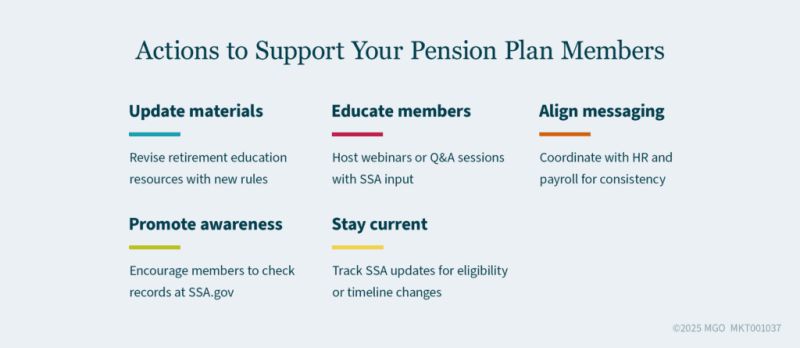- within Employment and HR topic(s)
- with Senior Company Executives, HR and Inhouse Counsel
- in United States
- with readers working within the Accounting & Consultancy and Retail & Leisure industries
Key Takeaways:
- The Social Security Fairness Act repeals the Windfall Elimination Provision and Government Pension Offset, restoring full Social Security benefits for many public employees with government pensions.
- Retroactive payments are already being distributed automatically by the Social Security Administration.
- Pension plan administrators should update communications, education materials, and planning tools to help members navigate these changes.
On January 5, 2025, a long-anticipated shift in retirement policy became law. The Social Security Fairness Act repealed two provisions — the Windfall Elimination Provision (WEP) and the Government Pension Offset (GPO) — that reduced Social Security benefits for public servants who also receive a government pension.
If you manage a state or local government pension plan, this change directly affects your retirees — and your operations. Here's what you need to know to support your members and keep your plan aligned with the new landscape.
What Changed and Why It Matters
For decades, the WEP and GPO created a financial penalty for public employees who split their careers between Social Security-covered and non-covered employment. These provisions reduced or eliminated Social Security benefits for individuals who also received a pension from non-covered government work — including many teachers, police officers, firefighters, and federal employees under the Civil Service Retirement System (CSRS).
With the passage of the Social Security Fairness Act, these reductions are gone. Public servants who paid into Social Security — even for part of their careers — will now receive full benefits, regardless of their pension status.
Who's Affected and Who's Not
It's important to note that not all public employees were impacted by the WEP or GPO. According to the Social Security Fairness Act page on ssa.gov (last updated July 21, 2025), about 72% of state and local government workers are in Social Security-covered positions not subject to these provisions.
The repeal primarily benefits:
- Retirees receiving pensions from non-covered employment
- Public employees with split careers (e.g., early years in private sector and later years in public service)
- Spouses and surviving spouses whose benefits were reduced under the GPO
If your plan includes members who fall into these categories, they may already be seeing changes in their Social Security payments.

Retroactive Benefits: What to Expect
One of the most impactful elements of the law is its retroactive application. The repeal of the WEP and GPO is effective as of January 2024, and the Social Security Administration began issuing back payments in early 2025.
Here's what your members need to know:
- Lump-sum payments are being issued to eligible individuals to cover the difference in benefits from January 2024 through early 2025.
- The average retroactive payment is approximately $6,710 per recipient (according to a March 5, 2025, Social Security Administration post).
- Monthly benefit increases began appearing in April 2025, reflecting March 2025 benefits.
- No action is required by beneficiaries — the SSA is issuing payments automatically based on existing records.
As of July 2025, the Social Security Administration states that over 3.1 million payments totaling $17 billion have been distributed — five months ahead of schedule.
What This Means for Your Pension Plan
While the law doesn't change your plan's funding or benefit structure, it does change the retirement income picture for many of your members. That has implications for:
1. Retirement Planning Support
Your members may need help understanding how their total retirement income has changed. Consider updating your retirement education materials and offering webinars or one-on-one sessions to walk through the new Social Security landscape.
With the repeal of the WEP and GPO, many retirees will see a meaningful increase in their monthly income — and possibly a lump-sum retroactive payment. Helping them understand how this affects their budgeting, tax planning, and long-term financial goals will be essential.
This is also an opportunity to reinforce the value of your pension plan as part of a more robust and equitable retirement strategy.
2. Member Communications
Transparency is key. Your members may have questions about how this change affects their benefits — and what steps they need to take. While the SSA is handling payments, your team can play a vital role in:
- Clarifying eligibility for retroactive payments
- Directing members to SSA resources and contact points
- Reinforcing that their pension benefits remain unchanged
Consider issuing a formal communication — such as a newsletter insert or email bulletin — to explain the repeal and its implications in plain language.
3. Coordination with Financial Advisors
Many retirees work with financial planners who may not be fully aware of the repeal's impact. Encourage your members to revisit their retirement income strategies, especially if they previously assumed reduced Social Security benefits.
This is also a good time to review any retirement calculators or planning tools your plan offers. Make sure they reflect the new Social Security rules to avoid confusion or underestimations.
The content of this article is intended to provide a general guide to the subject matter. Specialist advice should be sought about your specific circumstances.


